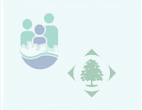









Keeping people safe & well
|
NCLB Coordinators' Guide
Collaboration and Relationships with partners
Successful implementation of the NCLB strategy requires ongoing collaboration among Steering Committee members as well as other community stakeholders. What does collaboration really mean? Let’s look at that now.
In this section, we will explore the coordinator’s role relative to helping to develop and implement collaborative partnerships as a means of achieving the goals and objectives outlined in the strategy. The responsibility of the NCLB Coordinator for managing critical relationships with partner agencies will also be investigated.
Section Objectives
- How to collaborate with Steering Committee members and members of the various subcommittees;
- How to identify, strengthen and develop relationships with key partners and build networks, both formal and informal;
- How to mobilize the community.
What can I do to encourage collaborations between Steering Committee and subcommittee members?
One of the primary roles of a NCLB coordinator is to encourage collaboration among the various organizations, agencies and residents involved in understanding that NCLB is not a program, but rather a strategy that establishes a base for building collaboration.The City of Ottawa is looking to realign existing resources for community development, leverage opportunities to meet the needs of the selected communities. The City follows a systematic approach for neighbourhood selection, which is a critical step in launching the CDF strategy approach. Given the amount of available community development resources to support each site, it is important for the Steering Committee to understand the importance of collaborations as a means to leverage additional resources for the NCLB site which, in turn, helps everyone achieve the communities goals and objectives.
There are a number of tasks NCLB coordinators are expected to perform in order to help clarify for Steering Committee and subcommittee members how important collaborations and partnerships are in implementing the NCLB strategy.
- Understand their roles and responsibilities;
- Secure commitment and involvement;
- identify key partners who share the vision even if they are presently not investing directly in the designated communities;
- Review the present committee membership and identify gaps;
- Analyze the size of the Steering Committee to determine that it is large enough to be inclusive of all shareholders, but small enough to be efficient and manageable;
- Review partners to ascertain strong representation for all the core components: social, physical, economic and service;
- Define permanent and visiting members;
- Permanent and visiting members will vary from one site to another. The general rule is that each Steering Committee member represents one agency or segment of the community. Since one Steering Committee covers more than one neighbourhood, representatives from a neighbourhood are invited when an issue or community action plan related to that specific community is on the meeting agenda.
- Appointing people as members of subcommittees or ad hoc committees is a good way of including more people while keeping the Steering Committee at a manageable size.
- Evaluate progress toward the short and long-term goals as part of the on-going review of the site’s operation.
Meeting place
The NCLB sites and coordinators are encouraged to have meeting places as part of the overall strategy. The communities need to have community houses or other meeting places available for regular weekly meetings and things like youth drop-in activities.
A meeting place is a location in or near the community where residents can access needed services, develop relationships, and find opportunities. It should be easily visible and readily accessible to area residents. Meeting at the respective CHRC is a good alternative if there is no meeting place available.
While considering various elements of a meeting place, it is important to look into the location, security and accessibility in the evening hours.
• Existing facilities
- Community Houses in OCH communities;
- City recreational/community facilities;
- Community-based organizations;
- Faith-based organizations;
- Non-profit organizations;
- Schools;
- Businesses.• Services and supportive programs
- Adults;
- Seniors;
- Youth;
- Children.• Staffing alternatives
- Community-based organizations;
- Paid staff;
- Volunteers.• Documentation and evaluation of activities
Without an appropriate meeting place, it won’t be easy to hold regular community meetings. Community members are usually available in the evening. The best possible way for consistently engaging the community and building a trust relationship with the service providers is to have an accessible location where the community members feel at home. A small budget for food and drinks can be used to encourage more community members to participate.
How does the NCLB Coordinator build, strengthen, and develop relationships with key partners?
In most cases, the community development staff members of the CHRCs are interacting with all service providers in one capacity or other. Seeking to build collaboration must not be a challenge for the NCLB Coordinator.
A significant portion of a site coordinator’s time is devoted to strengthening or building relationships with key community partners, who may not be presently involved with NCLB. Others may be involved, but not to the extent necessary to effect permanent, positive change.The best way for keeping partners engaged is simply working together. The more they are involved in assisting the community in implementing the Community Action Plans in various ways, the more relationships are developed and enhanced.
It usually takes some time, but sooner or later all partnering agencies find out a way to get fully involved in the collaborative and integrated approach to service provision according to the community identified needs and priorities.
Each partner agency presents its progress report in the NCLB Steering Committee meeting, thus keeping everyone abreast of the developments in the field and opening up new opportunities for resources leveraging and further collaboration.
Who are the ideal partners for NCLB?
While the service providers may vary from neighbourhood to neighbourhood based on the issues and prioritized needs, agencies serving communities across the board are most likely to be part of the community’s strategy development process and resultant action plan. Some of the potential partners are:
- Parks and Recreation Staff of the City of Ottawa;
- Ottawa Police Service;
- Ottawa Community Housing;
- Boys and Girls Club;
- Youth Services Bureau;
- Children’s Aid Society;
- Legal Aid Clinic;
- Local Councillors;
- Community-based organizations;
- Community House Directors;
- Representatives from local businesses;
- Representatives from funding agencies;
- Tenants/Residents’ Associations.
What should a coordinator do if the site is not developing collaborations and partnerships?
Sometimes, despite the efforts that coordinators may be putting into building or strengthening collaborations, the outcome is not what they or others may think it should be. Here are some quick questions for the coordinators to ask themselves as well as the Steering Committee if they continue to have difficulties in that area.How do I manage working relationships with partner agencies, funders and other organizations?
One of the common tactics of Steering Committees in implementing the tasks and activities outlined in the Strategy is to establish non-contractual, informal relationships with various service providers in the community. These informal relationships reflect an additional extension of the Coordinator’s responsibilities in managing collaborative activities. To the contrary, funders of various programs or activities under the NCLB process are directly connected to the NCLB site by a financial and reporting commitment. This section will highlight steps a coordinator should take to manage these important relationships. Remember, the purpose of implementing another level of contractual relationships is to fulfill the objectives outlined in the Strategy. Outcomes of funders must align to these objectives.• Get and Keep Everything In Writing
- Define and put in writing how funds must be spent to comply with the decisions of the Steering Committee;
- Define and put in writing, the roles and reporting requirements of each funder;
- Define and put in writing performance requirements developed to comply with the goals and objectives;
- Define how budget adjustments, changes to the scope of work, or extensions will be handled;
- Define and put in writing what the reporting process will be, including dates, content, and what will happen if performance objectives are not met.• Review funder’s Policies and Procedures
- Identify funder’s polices and regulations on contracting and clarify their relationship to the NCLB process
How do I mobilize community residents?
Community residents are one of the most important partners in the NCLB approach to community development. Having residents involved in all aspects of the NCLB process helps to ensure that the goals and objectives identified in the Strategy are consistent with the vision and desires of the people who live in the community.To ensure that residents are fully involved in NCLB, the strategy mandates that residents are one of the key required partners on the Steering Committee. Of course, it is not possible to have representatives from all the designated neighbourhoods at one time. However, representatives of the community should be around the table when the Community Action Plan for any specific community is on the agenda. In the case of OCH communities, the Community House Directors are usually the ambassadors for their respective communities along with the office-bearers of the Tenants’ Associations.
It is also expected that residents serve on the subcommittees and be part of all focus groups. Although residents may be involved on the various NCLB committees and activities, there is much more that a NCLB coordinator is expected to do to continuously involve and mobilize the community. The following are some of the steps and activities for successfully mobilizing residents:
Continually Survey the Community to Identify Needs, Issues and Concerns
- Conduct focus groups and neighbourhood surveys on an annual basis;
- Examine the Community Action Plan to ensure that it is current;
- Build strong resident-led leadership structures;
- Focus on capacity building of the Tenants’ Association in close collaboration with other partners – particularly OCH staff in OCH communities;
- Create strong communication vehicles that meet the needs of the community.
Market the NCLB site using
- Neighbourhood meetings;
- Newsletters;
- Public service announcements;
- Websites ;
- Look for mobilization opportunities that match with your NCLB strategy;
- Link plans with national, regional, and local events;
- Take advantage of other things going on in the community (festivals, street fairs, rallies, door-to-door canvassing);
- Give recognition to volunteers and hold celebrations;
- Be accessible to the community.
System level support under the Community Development Framework (CDF)
Please refer to the NCLB strategy and implementation guide which explains how system level support is being provided through various tables, such as Community Development Round Table, Community Table, Municipal Service and Knowledge Transfer table. Issues, which the partners may not be able to address at the local Steering Community level or which need some policy level decision, are brought up to the Community Table where ideas and recommendations are framed and coordination support is extended to access support and guidance from the other tables. A representative from each local Steering Committee sits on the Community Table.Summary
Collaborations and partnerships are the lifeblood of the NCLB Strategy. Upon completion of this learning section, The NCLB coordinators should have a better understanding of how to work productively with the site’s Steering Committee, subcommittees, and key partners. In addition, tips were offered on how to enhance, strengthen, and sustain key partnerships, as well as, how to identify and involve stakeholders.Beyond building a network of partners, this section also focused on how to mobilize the community to achieve the goals outlined in the NCLB Strategy. The coordinators should now have more insight on how to connect clients to services, and what is required in managing funds for activities from other funders.











©
2005-15 South - East Ottawa Community Health Centre
Centre de Sante Communautaire du Sud Est D'Ottawa
Contact: Abid Jan Tel./ Tél: (613) 737-5115 Ext. 2403 Fax/Télé: (613) 739-8199
NCLB matters because neighbourhoods matter

